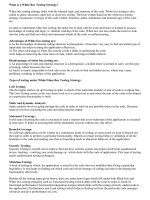Black Box and White Box testing
Bạn đang xem bản rút gọn của tài liệu. Xem và tải ngay bản đầy đủ của tài liệu tại đây (216.04 KB, 9 trang )
1 Black Box and White Box testing
1.1 Introduction
Test Design refers to understanding the sources of test cases, test coverage, how to develop and
document test cases, and how to build and maintain test data. There are 2 primary methods by which
tests can be designed and they are:
- BLACK BOX
- WHITE BOX
Black-box test design treats the system as a literal "black-box", so it doesn't explicitly use knowledge
of the internal structure. It is usually described as focusing on testing functional requirements.
Synonyms for black-box include: behavioral, functional, opaque-box, and closed-box.
White-box test design allows one to peek inside the "box", and it focuses specifically on using internal
knowledge of the software to guide the selection of test data. It is used to detect errors by means of
execution-oriented test cases. Synonyms for white-box include: structural, glass-box and clear-box.
While black-box and white-box are terms that are still in popular use, many people prefer the terms
"behavioral" and "structural". Behavioral test design is slightly different from black-box test design
because the use of internal knowledge isn't strictly forbidden, but it's still discouraged. In practice, it
hasn't proven useful to use a single test design method. One has to use a mixture of different methods
so that they aren't hindered by the limitations of a particular one. Some call this "gray-box" or
"translucent-box" test design, but others wish we'd stop talking about boxes altogether!!!
1.2 Black box testing
Black Box Testing is testing without knowledge of the internal workings of the item being tested. For
example, when black box testing is applied to software engineering, the tester would only know the
"legal" inputs and what the expected outputs should be, but not how the program actually arrives at
those outputs. It is because of this that black box testing can be considered testing with respect to the
specifications, no other knowledge of the program is necessary. For this reason, the tester and the
programmer can be independent of one another, avoiding programmer bias toward his own work. For
this testing, test groups are often used,
Though centered around the knowledge of user requirements, black box tests do not necessarily involve
the participation of users. Among the most important black box tests that do not involve users are
functionality testing, volume tests, stress tests, recovery testing, and benchmarks . Additionally, there
are two types of black box test that involve users, i.e. field and laboratory tests. In the following the most
important aspects of these black box tests will be described briefly.
1.2.1.1 Black box testing - without user involvement
The so-called ``functionality testing'' is central to most testing exercises. Its primary objective is to
assess whether the program does what it is supposed to do, i.e. what is specified in the requirements.
There are different approaches to functionality testing. One is the testing of each program feature or
function in sequence. The other is to test module by module, i.e. each function where it is called first.
The objective of volume tests is to find the limitations of the software by processing a huge amount of
data. A volume test can uncover problems that are related to the efficiency of a system, e.g. incorrect
buffer sizes, a consumption of too much memory space, or only show that an error message would be
needed telling the user that the system cannot process the given amount of data.
During a stress test, the system has to process a huge amount of data or perform many function calls
within a short period of time. A typical example could be to perform the same function from all
workstations connected in a LAN within a short period of time (e.g. sending e-mails, or, in the NLP area,
to modify a term bank via different terminals simultaneously).
The aim of recovery testing is to make sure to which extent data can be recovered after a system
breakdown. Does the system provide possibilities to recover all of the data or part of it? How much can
be recovered and how? Is the recovered data still correct and consistent? Particularly for software that
needs high reliability standards, recovery testing is very important.
The notion of benchmark tests involves the testing of program efficiency. The efficiency of a piece of
software strongly depends on the hardware environment and therefore benchmark tests always
consider the soft/hardware combination. Whereas for most software engineers benchmark tests are
concerned with the quantitative measurement of specific operations, some also consider user tests that
compare the efficiency of different software systems as benchmark tests. In the context of this
document, however, benchmark tests only denote operations that are independent of personal
variables.
1.2.1.2 Black box testing - with user involvement
For tests involving users, methodological considerations are rare in SE literature. Rather, one may find
practical test reports that distinguish roughly between field and laboratory tests. In the following only a
rough description of field and laboratory tests will be given. E.g. Scenario Tests. The term ``scenario''
has entered software evaluation in the early 1990s . A scenario test is a test case which aims at a
realistic user background for the evaluation of software as it was defined and performed It is an instance
of black box testing where the major objective is to assess the suitability of a software product for every-
day routines. In short it involves putting the system into its intended use by its envisaged type of user,
performing a standardised task.
In field tests users are observed while using the software system at their normal working place. Apart
from general usability-related aspects, field tests are particularly useful for assessing the interoperability
of the software system, i.e. how the technical integration of the system works. Moreover, field tests are
the only real means to elucidate problems of the organisational integration of the software system into
existing procedures. Particularly in the NLP environment this problem has frequently been
underestimated. A typical example of the organisational problem of implementing a translation memory
is the language service of a big automobile manufacturer, where the major implementation problem is
not the technical environment, but the fact that many clients still submit their orders as print-out, that
neither source texts nor target texts are properly organised and stored and, last but not least, individual
translators are not too motivated to change their working habits.
Laboratory tests are mostly performed to assess the general usability of the system. Due to the high
laboratory equipment costs laboratory tests are mostly only performed at big software houses such as
IBM or Microsoft. Since laboratory tests provide testers with many technical possibilities, data collection
and analysis are easier than for field tests.
1.3 Testing Strategies/Techniques
• Black box testing should make use of randomly generated inputs (only a test range should be
specified by the tester), to eliminate any guess work by the tester as to the methods of the
function
• Data outside of the specified input range should be tested to check the robustness of the
program
• Boundary cases should be tested (top and bottom of specified range) to make sure the highest
and lowest allowable inputs produce proper output
• The number zero should be tested when numerical data is to be input
• Stress testing should be performed (try to overload the program with inputs to see where it
reaches its maximum capacity), especially with real time systems
• Crash testing should be performed to see what it takes to bring the system down
• Test monitoring tools should be used whenever possible to track which tests have already been
performed and the outputs of these tests to avoid repetition and to aid in the software
maintenance
• Other functional testing techniques include: transaction testing, syntax testing, domain testing,
logic testing, and state testing.
• Finite state machine models can be used as a guide to design functional tests
• According to Beizer the following is a general order by which tests should be designed:
1. Clean tests against requirements.
2. Additional structural tests for branch coverage, as needed.
3. Additional tests for data-flow coverage as needed.
4. Domain tests not covered by the above.
5. Special techniques as appropriate--syntax, loop, state, etc.
6. Any dirty tests not covered by the above.
1.4 Black box testing Methods
1.4.1 Graph-based Testing Methods
• Black-box methods based on the nature of the relationships (links) among the program objects
(nodes), test cases are designed to traverse the entire graph
• Transaction flow testing (nodes represent steps in some transaction and links represent logical
connections between steps that need to be validated)
• Finite state modeling (nodes represent user observable states of the software and links
represent transitions between states)
• Data flow modeling (nodes are data objects and links are transformations from one data object
to another)
• Timing modeling (nodes are program objects and links are sequential connections between
these objects, link weights are required execution times)
1.4.2 Equivalence Partitioning
• Black-box technique that divides the input domain into classes of data from which test cases
can be derived
• An ideal test case uncovers a class of errors that might require many arbitrary test cases to be
executed before a general error is observed
• Equivalence class guidelines:
1. If input condition specifies a range, one valid and two invalid equivalence classes are
defined
2. If an input condition requires a specific value, one valid and two invalid equivalence
classes are defined
3. If an input condition specifies a member of a set, one valid and one invalid equivalence
class is defined
4. If an input condition is Boolean, one valid and one invalid equivalence class is defined
1.4.3 Boundary Value Analysis
• Black-box technique that focuses on the boundaries of the input domain rather than its center
• BVA guidelines:
1. If input condition specifies a range bounded by values a and b, test cases should
include a and b, values just above and just below a and b
2. If an input condition specifies and number of values, test cases should be exercise the
minimum and maximum numbers, as well as values just above and just below the
minimum and maximum values
3. Apply guidelines 1 and 2 to output conditions, test cases should be designed to
produce the minimum and maxim output reports
4. If internal program data structures have boundaries (e.g. size limitations), be certain to
test the boundaries
1.4.4 Comparison Testing
• Black-box testing for safety critical systems in which independently developed implementations
of redundant systems are tested for conformance to specifications
• Often equivalence class partitioning is used to develop a common set of test cases for each
implementation
1.4.5 Orthogonal Array Testing
• Black-box technique that enables the design of a reasonably small set of test cases that provide
maximum test coverage
• Focus is on categories of faulty logic likely to be present in the software component (without
examining the code)
• Priorities for assessing tests using an orthogonal array
1. Detect and isolate all single mode faults
2. Detect all double mode faults
3. Multimode faults
1.4.6 Specialized Testing
• Graphical user interfaces
• Client/server architectures
• Documentation and help facilities
• Real-time systems
1. Task testing (test each time dependent task independently)
2. Behavioral testing (simulate system response to external events)
3. Intertask testing (check communications errors among tasks)
4. System testing (check interaction of integrated system software and hardware)
1.4.7 Advantages of Black Box Testing
• More effective on larger units of code than glass box testing
• Tester needs no knowledge of implementation, including specific programming languages
• Tester and programmer are independent of each other
• Tests are done from a user's point of view
• Will help to expose any ambiguities or inconsistencies in the specifications
• Test cases can be designed as soon as the specifications are complete
1.4.8 Disadvantages of Black Box Testing
• Only a small number of possible inputs can actually be tested, to test every possible input
stream would take nearly forever
• Without clear and concise specifications, test cases are hard to design
• There may be unnecessary repetition of test inputs if the tester is not informed of test cases the
programmer has already tried
• May leave many program paths untested
• Cannot be directed toward specific segments of code which may be very complex (and
therefore more error prone)
• Most testing related research has been directed toward glass box testing
1.5 Black Box (Vs) White Box
An easy way to start up a debate in a software testing forum is to ask the difference between black box
and white box testing. These terms are commonly used, yet everyone seems to have a different idea of
what they mean.
Black box testing begins with a metaphor. Imagine you’re testing an electronics system. It’s housed in a
black box with lights, switches, and dials on the outside. You must test it without opening it up, and you
can’t see beyond its surface. You have to see if it works just by flipping switches (inputs) and seeing
what happens to the lights and dials (outputs). This is black box testing. Black box software testing is
doing the same thing, but with software. The actual meaning of the metaphor, however, depends on
how you define the boundary of the box and what kind of access the “blackness” is blocking.
An opposite test approach would be to open up the electronics system, see how the circuits are wired,
apply probes internally and maybe even disassemble parts of it. By analogy, this is called white box
testing,
To help understand the different ways that software testing can be divided between
black box and white box techniques, consider the Five-Fold Testing System. It lays
out five dimensions that can be used for examining testing:
1.People(who does the testing)
2. Coverage (what gets tested)
3. Risks (why you are testing)
4.Activities(how you are testing)
5. Evaluation (how you know you’ve found a bug)
Let’s use this system to understand and clarify the characteristics of black box and
white box testing.
People: Who does the testing?
Some people know how software works (developers) and others just use it (users). Accordingly, any
testing by users or other non-developers is sometimes called “black box” testing. Developer testing is
called “white box” testing. The distinction here is based on what the person knows or can understand.
Coverage: What is tested?
If we draw the box around the system as a whole, “black box” testing becomes another name for system
testing. And testing the units inside the box becomes white box testing. This is one way to think about
coverage. Another is to contrast testing that aims to cover all the requirements with testing that aims to
cover all the code. These are the two most commonly used coverage criteria. Both are supported by
extensive literature and commercial tools. Requirements-based testing could be called “black box”
because it makes sure that all the customer requirements have been verified. Code-based testing is
often called “white box” because it makes sure that all the code (the statements, paths, or decisions) is
exercised.
Risks: Why are you testing?
Sometimes testing is targeted at particular risks. Boundary testing and other attack-based techniques
are targeted at common coding errors. Effective security testing also requires a detailed understanding
of the code and the system architecture. Thus, these techniques might be classified as “white
box”. Another set of risks concerns whether the software will actually provide value to users. Usability
testing focuses on this risk, and could be termed “black box.”
Activities: How do you test?
A common distinction is made between behavioral test design, which defines tests based on functional
requirements, and structural test design, which defines tests based on the code itself. These are two
design approaches. Since behavioral testing is based on external functional definition, it is often called









